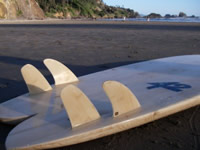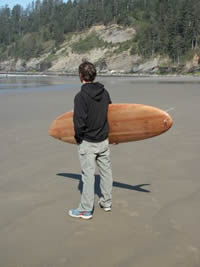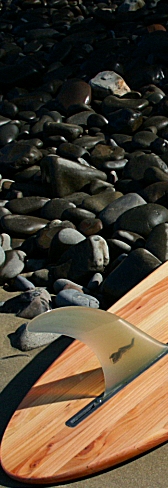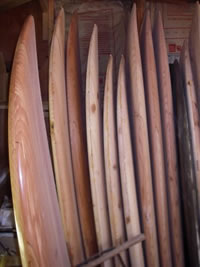42 Surboards: Lars Bergström Interview
Wooden surfboards are an interesting animal. They were the first, and some believe they’ll be the last. They can be super fast and responsive. They can be beautiful and last a lifetime. And yet, many people still view them as throwback technology and low performance wave tools.
 There are however some seriously committed shapers/surfers out there rapidly changing this image and Lars Bergström of 42 Surfboards is no exception.
There are however some seriously committed shapers/surfers out there rapidly changing this image and Lars Bergström of 42 Surfboards is no exception.
42 Surfboards is based in Oregon. They make chambered wooden surfboards and focus on a sustainable business model. This means maximizing every resource used in production and keeping work fun and rewarding. Lars is eloquent and well versed in the science of sustainability. Please be sure to check out 42’s blog and website. As always, we welcome your feedback and comments.
Main Website: http://www.42surfboards.com/index.html
42 Blog: http://42surfboards.blogspot.com/
Lars Bergström Interview
Q. There are so many things I’d like to ask you but I think first it would be cool to know how you went from a PhD. in Environmental Studies to making wooden surfboards full time (or vice versa I guess)? Are you from Oregon?
Like most things in life, there is no pattern until you look back. And you don’t get to look back until it is all over. Which makes me a little apprehensive about looking back… Still, if I had to wager a guess, I think it probably all happened at the same time.
 I grew up in Laguna Beach, California. My dad went to school in Laguna and ran track on the same team as Billy Hamilton and a bunch of other great surfers. We lived down there, surfing, sailing and playing in the water until I was about twelve. At that point my parents had had all the crowds that they could handle and we moved up the coast to the Northwest. I shaped boards all through high school before moving first to Europe and then to Maui. Riding my boards in different conditions around the world has definitely influenced what I think about what shapes work well in different conditions.
I grew up in Laguna Beach, California. My dad went to school in Laguna and ran track on the same team as Billy Hamilton and a bunch of other great surfers. We lived down there, surfing, sailing and playing in the water until I was about twelve. At that point my parents had had all the crowds that they could handle and we moved up the coast to the Northwest. I shaped boards all through high school before moving first to Europe and then to Maui. Riding my boards in different conditions around the world has definitely influenced what I think about what shapes work well in different conditions.
For someone who eventually ended up with a Ph.D., my life has been remarkably centered on surfing. Growing up, that’s just what we did every day. As a teen, I skipped out on a year of high school and spent it surfing. Then after high school I took off for another couple years and spent them surfing. And again after my bachelors’ degree. And again after my masters degree. And now again, surfing is just what I do.
It wasn’t until after earning my Ph.D. in environmental science and teaching at a number of universities though, that I switched from shaping foam to wood. Here I was teaching my students about what needed to be done, or what could be done, and I just felt like it was time to put my money where my mouth was. Or maybe my planer where my mouth was.
Q. Before we talk about your boards I’m really interested in knowing more about the workings of your factory. I understand that you use sustainably harvested wood, recycle all of your waste, etc. Tell us about your sustainable business approach to 42.
The sustainable approach at 42 Surfboards is a work in progress. It isn’t something that is ever finished. Instead, it is how we come to work every morning. Every day we look at the work that we do and ask ourselves if there is a better way. Where are our materials coming from? How far did they have to travel? Are we happy with how our woods are grown and harvested? How much energy is used in building our blanks and shaping our boards? Where is that energy coming from? How much waste are we generating? How much of that can be reused? How much can be recycled? Is there a “higher” use for any of that waste? And every day, we push a little further.
In the end though, and at the core of our sustainable approach, is the quality of our surfboards. Just as we are constantly pushing for the most sustainable approach possible, we are also constantly pushing for the most durable approach to construction and design.
Between those two things, we hope to not only have the least environmental impact of any board builder on the planet but to actually have a net positive impact on both our local and global environment.
Q. You are part of the 1% For The Planet initiative. Additionally, you drastically reduced the prices on all of your boards, some by $1000. What gives? Yvon Chouinard talks a lot about (in Let My People Go Surfing) controlling growth to keep the company sane and employees happy. Where do you see your company’s growth in the future as wait times increase?
 Edward Abbey once said something on the order of “Constant growth is the philosophy of a cancer cell.” I admire Yvon Chouinard and “Let my people go surfing” is required reading for all of our employees at 42 Surfboards. But I greatly admire the work of Edward Abbey and 42 Surfboards is not here to grow. 42 Surfboards is not here to become some mega-conglomerate. 42 Surfboards is here to build surfboards, be a great place to work, and show that you can have a positive impact on the environment while feeding your kids and doing something you love.
Edward Abbey once said something on the order of “Constant growth is the philosophy of a cancer cell.” I admire Yvon Chouinard and “Let my people go surfing” is required reading for all of our employees at 42 Surfboards. But I greatly admire the work of Edward Abbey and 42 Surfboards is not here to grow. 42 Surfboards is not here to become some mega-conglomerate. 42 Surfboards is here to build surfboards, be a great place to work, and show that you can have a positive impact on the environment while feeding your kids and doing something you love.
Being part of 1% For The Planet and The Surfrider Foundation are not something we do for image or marketing. These fantastic groups are actually part of our reason for existing. It is thrilling to take part of our earnings and commit them to real on-the-ground activism. At the same time though, it is an investment that any business that actually cares about our environment can’t afford to miss. Just as David Brower said “There is no business to be done on a dead planet”, there are no waves to be ridden in a dead ocean. We hope that all of our colleagues will join us in supporting 1% For The Planet and The Surfrider Foundation.
Reducing the prices of our boards this year had nothing to do with growth. Instead, it had everything to do with building surfboards. At 42 Surfboards, we want to build the best surfboards in the world. Beautiful, yes. Sustainable, yes. Durable, you bet. Ripping, absolutely! So while we are honored that people were treating our boards as art, we are more honored when we see riders pull into a ten-foot Puerto barrel on something that we have shaped for them. The reduction of our prices from around $2500 to $1400 was intended pull boards off of living-room walls and put them up on long green walls all over the world. And so far, so good. The only drawback for our customers has been that the waiting line has gotten a little longer.
This leads right into the idea that one of 42 Surfboards’ reasons for existing is to be a great place to work. We refuse to freak out about waiting lines that ebb and flow. Instead, we take great care of our customers, put just as much care into every single surfboard, and we refuse to take deposits. In other words, every board is equally important to us. And if your board takes two months for our crew to get to you, that’s just how long it takes. By refusing deposits, we have lowered the queue-crankiness by a factor of ten. At the moment, boards have been taking six to ten weeks to get to our customers and that is something that everybody seems totally comfortable with.
Our growth to date has felt very natural. We aren’t out hyping our boards. People see them, see what they do, and they want them. And every year the word slowly spreads. And every year we slowly add employees to satisfy that demand. When that demand curve stops climbing and we have all of the people we need to do what we do, our growth will have come to its natural end. And we will still be having the best time of any group of people that I know who build surfboards for a living.
The secret to a good board? Perfection is the only acceptable result. The secret to a good company? Low expectations. At 42 Surfboards, its not about the “company”. Only the boards need to be perfect.
Q. Having lived in Portland, Oregon for a few years I know that locally made, socially and environmentally responsible products are not a hard sell. Where do your customers come from and have you had any challenges overcoming the stigma of the wooden surfboard?
Our customers come from all over the world. And I had no idea that there was a “wooden surfboard stigma” to overcome. The only response that I have ever gotten when someone sees one of our boards for the first time is absolute pure stoke. This is how boards have been built for 4000 years. OK, we are cheating with some of the tools we are using but, what the hell! It is, after all, the 21st century. But seriously, foam boards have only been popular since 1959 when some crabby chemist stole the formula from a fellow surfer and proceeded to monopolize the industry. There are no crabby chemists at 42 Surfboards. We are surfers who enjoy working with wood. And our customers are surfers who enjoy surfing a board that is simply better by nature.
Wood is not the newcomer on the block. Foam is the newcomer. Wood is cleaner to work with, easier on the planet, and rides better. Just ask the guy on the wood single fin that just caught ten waves to your one.
Q. I noticed that one of the longboards on the blog is chambered. Are the fishes and shortboards also chambered? Can you tell us a little about your construction methods and technical aspects of your boards like weight and volume?
 All of our boards are radically chambered. No blank builders to date have ever been able to build chambered wood blanks to the specifications that we are today. Between this and using crystal clear epoxy and bomber layups, our boards are burly but are very light. Not as light as the imported pop-out you can find on Isle 11 at Sprawlmart, but so light that I constantly have to remind people in the shop to be careful. Otherwise they grab the board and, thinking that they are going to be lifting a log, they ram it solidly up into the ceiling. Sheepishly.
All of our boards are radically chambered. No blank builders to date have ever been able to build chambered wood blanks to the specifications that we are today. Between this and using crystal clear epoxy and bomber layups, our boards are burly but are very light. Not as light as the imported pop-out you can find on Isle 11 at Sprawlmart, but so light that I constantly have to remind people in the shop to be careful. Otherwise they grab the board and, thinking that they are going to be lifting a log, they ram it solidly up into the ceiling. Sheepishly.
I have no clue what the volumes of our boards are. Our shapes are typically a little thicker with a little fuller rail than many of the other boards that you see in the water. This has less to do with the fact that we shape in wood and more to do with the idea that I like to build cheaters. Cheaters are boards that ride so well and so easy and grab you so many waves, that you feel like you are cheating. The rest of the world can feel like they are “progressing” by sitting neck deep in the lineup on their quad-fin skimboard. Don’t think I am not stoked to have them out there — I use that poor guy as my bouy marker so I know where to sit when I come back from my 50th wave of the session.
Q. We always want to know people’s different definitions and approach to the topic of sustainability. Having an academic background in environmental studies must have given you lots of exposure to the theories behind sustainability. But what are your views and how do you see it pertaining to the surf industry?
Sustainability is not BS. And it shouldn’t be about marketing. Sustainability means that your approach could continue on indefinitely. The idea can be applied to something small like 42 Surfboards, or your shopping habits, or your own household. Or it can be applied to something larger like capitalism. In the end though, sustainability is the only morally acceptable option. If you are not approaching your surfing, your business, and the rest of your life sustainably, you are stealing from your children and grandchildren. Period.
At the moment, I do not feel that many companies in the surf industry are taking sustainability seriously. And they won’t until their customers tell them, by taking their business to those who do, that sustainability really matters to them. And I can tell you from our experience that that is happening right now.
Q. We’ve interview Tom Wegener, Danny Hess and Paul Jensen, all master wood board craftsmen. Who has inspired your design methods?
I admire all of those guys, along with Mike Leveccia from Grain. They are all doing super cool things in so many different ways. But more than anybody, I have been influenced by my dad, my grandfather, and my great grandfather, all master woodworkers and watermen. I grew up surfing, sailing and working with my dad, Paul Bergstrom. He definitely taught me everything I know about working with wood. And it had been handed down the line to him from the two or three generations prior. To this day, many of the hand tools that we shape 42 Surfboards with originally belonged to my Great Grandfather and many of the fantastic power tools, big heavy steel beasts from Skil and Milwaukee, belonged to my Grandfather.
It may sound redundant coming from the shaper of chambered wood boards, but tradition is really important to us here at 42 Surfboards.
Q. Any words of wisdom /plans for the future?
Life is short. You are good. Ride a board that makes you proud.
This is a great article guys. Really inspiring. I love the part about using potato chip riders as line-up markers after catching your 50th wave of a session.
Where can I fondle one of these babies?
Yeah I like his mention of guys neck deep in the lineup on skimboards. To check out the boards give Lars a call at 541-490-9099. Drop us a line if you get to test one out.
you guys by any chance give discounts to public school teachers :) I saw the boards and they look so sweet, buying one in the future is definitely something to do. For the envioronment I hear you guys. I have switched to a clothesline to save electricity, use eco friendly cleaning products, car pool to work, etc….. useing a more eco friendly board would probably add a little more soul to my surfing.
I teach austistic students in Orlando florida and I have talked with parents of the children in the class on how some of the kids seemed normal and then one day changed. For one kid it was the day he got his vacination shots. I believe for other kids it is the chemicals in our foods, pesticides, hormones, etc… Putting harsh chemicals in our bodies that were not meant to be there will have a reaction sooner or later.
It seems our planet is starting to wake up to the fact that we have three material gods so to speak, our air, our food, and our water. My hats go off to you for helping to respect that and putting forth an effort
peace, love, and rise above
Neil